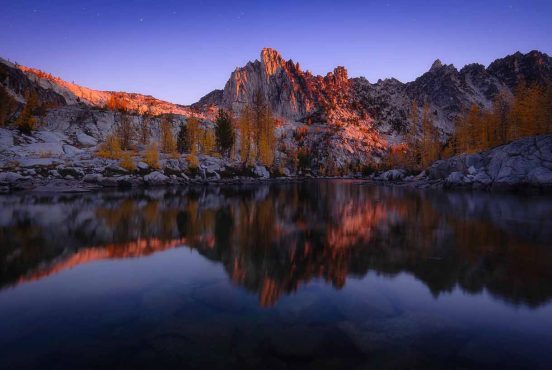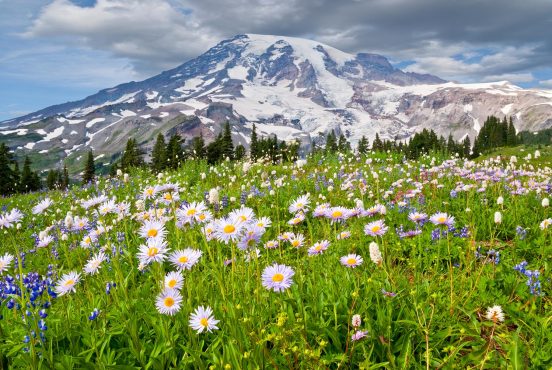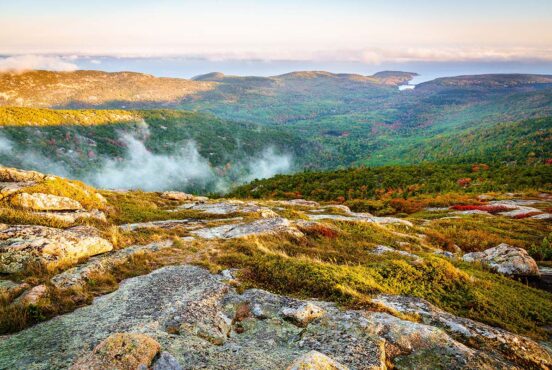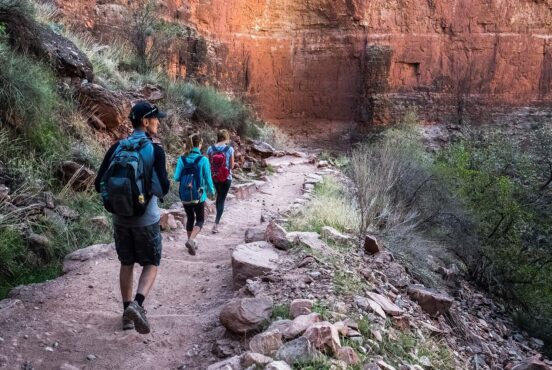Take a stroll upstream in the most iconic slot canyon in the west.
Wading upstream; leaning on a pole to pick your way through the Virgin River’s clear turquoise waters; dramatic canyon walls rise steeply around you. There’s no marked trail — just chart your own path through the rocky riverbed. I strain my neck to look for the sky above us and stare at the vertical walls, each a blend of burnt reds, charcoal grays, and deep blacks.
The Narrows is one of the most coveted hikes in Zion National Park, and for good reason. I’ve hiked through numerous national parks and renowned trails worldwide but have yet to experience one like this.
Sunlight barely filters into the narrow, steep canyon of the Narrows in Zion National Park. I’m bundled in a fleece, a down jacket, a beanie, shorts, and neoprene booties for the entire hike, even though the temperature was supposed to soar to a warm-and-sunny 80 degrees Fahrenheit on this clear October day. Even though the air temperature was hot, the inside of the canyon was cool. We spent the majority of the hike splashing through icy waters in the shade of the steep canyon.
If you plan to hike The Narrows, knowing what to expect and what to bring is essential. Luckily, we have you covered.

How to Hike The Narrows
You will get wet on this walk. There is no tip-toeing around it.
Once you step off the main path, you enter the river with a varying depth based on the current water levels. Hikers walk upstream through the Virgin River, meaning there’s no true trail. Instead, you’ll be walking on slippery and unstable rocks, crisscrossing back and forth to find shallower water or sandy beaches that make walking easier (if they exist, based on the water depth).
Before you head out, swing by the visitor’s center for current river levels, weather conditions, and flash flood warnings. This intel will help determine if you need to rent special gear for high waters or cooler temperatures. Also, if water levels are too high (usually in the spring), the park closes access to this hike.
CFS levels for the Virgin River:
- 0-30 cfs = ankle deep (for an average size adult)
- 30-60 cfs = ankle to knee deep.
- 60-90 cfs = knee to thigh deep. Walking above 70 cfs is challenging, and there are frequent pools that can be chest-deep.
- 90-120 cfs = thigh to waist deep.
- Over 150 cfs = Closed by the National Park Service

Does Hiking The Narrows Require a Permit?
There are two ways to hike The Narrows. The most popular and easily accessible way is from the Bottom Up, an out-and-back hike that does not require a permit and is accessed from within the park’s main entrance.
Alternatively, you can hike one way from the Top Down, which requires a Wilderness Permit. If you score a permit for the sixteen-mile trip through the Virgin River Narrows from Chamberlain’s Ranch to the Temple of Sinawava, it can be done on a very long and strenuous day or overnight trip.
How to Get to The Narrows (Bottom Up)
Once inside Zion National Park, hop on the in-park shuttle and stay on until the last stop (#9), the Temple of Sinawava. This is also the last stop for bathrooms.
Start walking up the canyon via the Riverside Walk, a wide, easy one-mile path along the Virgin River. You’ll enter the river in the canyon at the end of the Riverside Walk. From here, just head upstream.
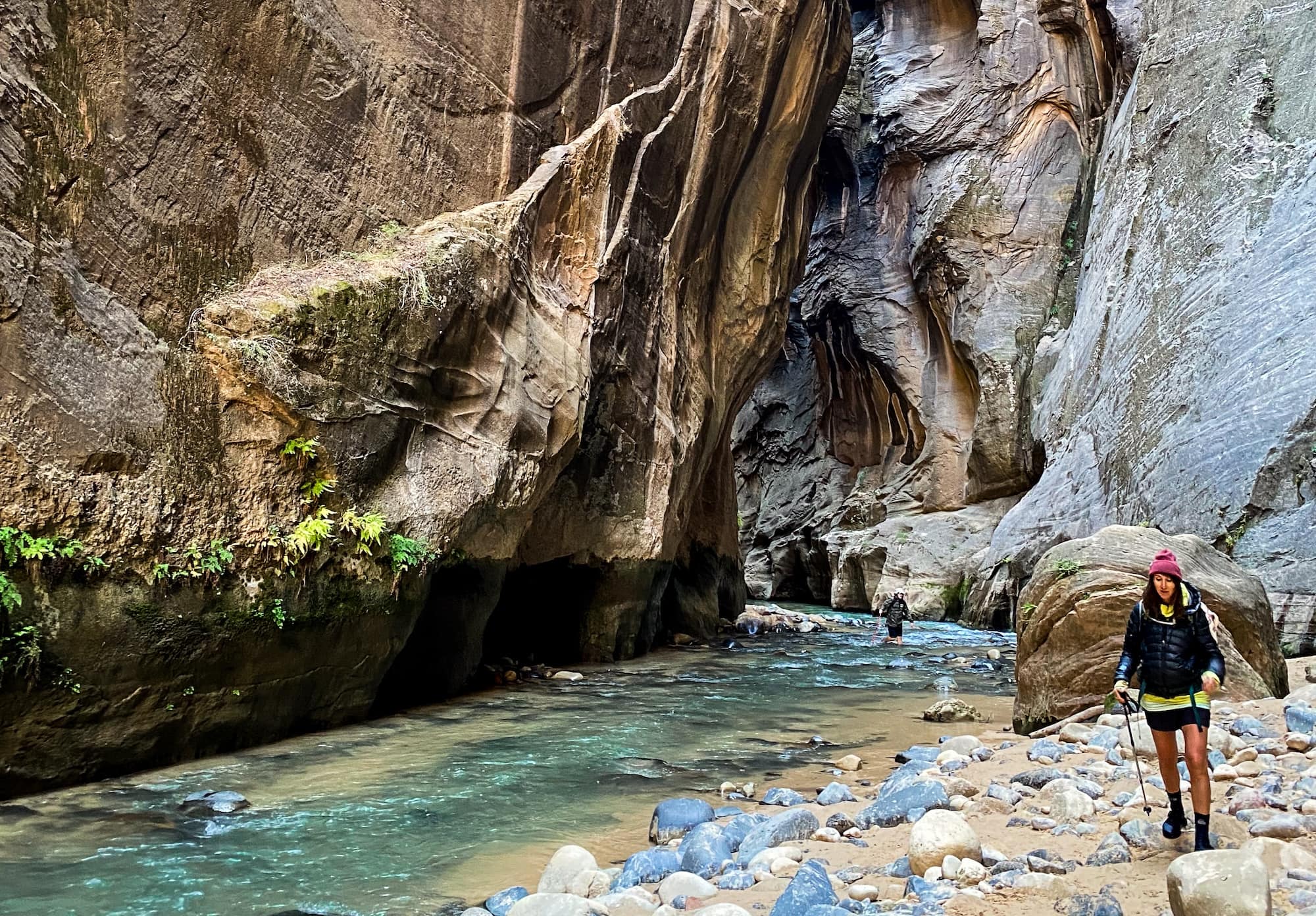
How Long is The Narrows Hike
Hiking The Narrows from the Bottom Up is an out-and-back hike so that you can choose the length of your adventure.
It’s a slow slog upstream. Expect to hike much slower than your average hiking pace as you fight against the water, especially with higher water levels. Luckily, the trek downstream will make up for lost time. Our 7.3-mile hike was 5+ hours (with stops).
If you’re up for the challenge, it’s worth it to venture to the Wall Street section, which begins three miles into the hike (two miles in the river). The roundtrip hike to the start of Wall Street is six miles.
Wall Street is the most spectacular part of The Narrows. It’s where the canyon narrows to 22 feet wide, creating a mesmerizing tunnel effect. Towering 1,500-foot walls engulf you as you peer into a glimpse of the sky above. With every twist and turn in the canyon, we were drawn deeper into the breathtaking beauty of Zion.
Our hike clocked in at over 7 miles. We hiked over half a mile past the start of Wall Street until we found a sunny, sandy beach (a rare gem in a steep canyon) to have lunch before we turned around. We could have hiked farther, but we were content with our discovery and as stunning as the scenery is, it remains consistent throughout this section.
Big Springs is the farthest you can hike without a permit for a day hike. Roundtrip, it’s a 9.4-mile hike.
When to Hike The Narrows
Zion can be visited year-round, and The Narrows can be hiked in the high summer, fall, or winter. Each season offers different benefits and challenges. However, hiking The Narrows in the spring is not recommended when the river is at its highest from snow runoff.
Hiking in the Summer: Mid-May Through Mid-September
Summer is the most popular season in Zion National Park. It’s also the hottest, making it the perfect time to seek shade and cool waters in the canyon. The water is still chilly from the winter run-off in early June but warms up throughout the summer.
There are two things to note about hiking in the Narrows in the summer: water levels vary this time of year depending on the snow from the previous winter. After a record snow year, the water can be raging in May and June.
Secondly, summer is the monsoon season. Thunderstorms typically occur late in the afternoon but can pop up anytime. Intense rain can cause flash flooding. An early morning start is essential to beat both the heat and potential thunderstorms.

Hiking in the Fall: Mid-September – early November
Fall is a fantastic time to visit Zion National Park and hike The Narrows. Water levels are low, and the extreme heat has subsided. I visited the park in early October, which was ideal. We were also lucky to catch a warm weather window. Late fall can have unpredictable weather (it snowed on us two days later), so check the forecast before heading out.
Low water levels made wading through the river more manageable since it was only ankle-to-knee deep. While it was cool in the canyon, we didn’t need to rent any special gear or equipment (other than neoprene booties). But the days are shorter, meaning even less light reaches the bottom of the canyon.
Hiking in the Winter: Early November – mid-March
Winter is the least busy time to visit Zion National Park. If you choose to hike The Narrows in the winter, you’ll need specialized equipment to stay warm, including a full dry suit and neoprene socks, which can be rented in Springdale. But if you’re willing to brave frigid temps and icy waters, you’ll be rewarded with solitude and icicles on this typically popular hike.
The road to Chamberlain Ranch is usually closed in the winter, making a through hike difficult. The best way to hike The Narrows in the winter is from the Bottom Up.
What to Wear When Hiking The Narrows
Hiking boots or running shoes are the best footwear to hike in the Narrows. Sturdy and supportive water shoes are essential because your shoes will get wet—and stay wet—for the rest of the trip. Proper footwear with a good grip on the sole is crucial because the river is filled with large, slick rocks.
Inappropriate footwear can lead to twisted ankles and crushed toes, so hiking with open-toed shoes is not recommended. Waterproof canyon boots can be rented, but we used our own shoes. Pro tip: Pack some lightweight shoes or sandals to change into after you get out of the river.
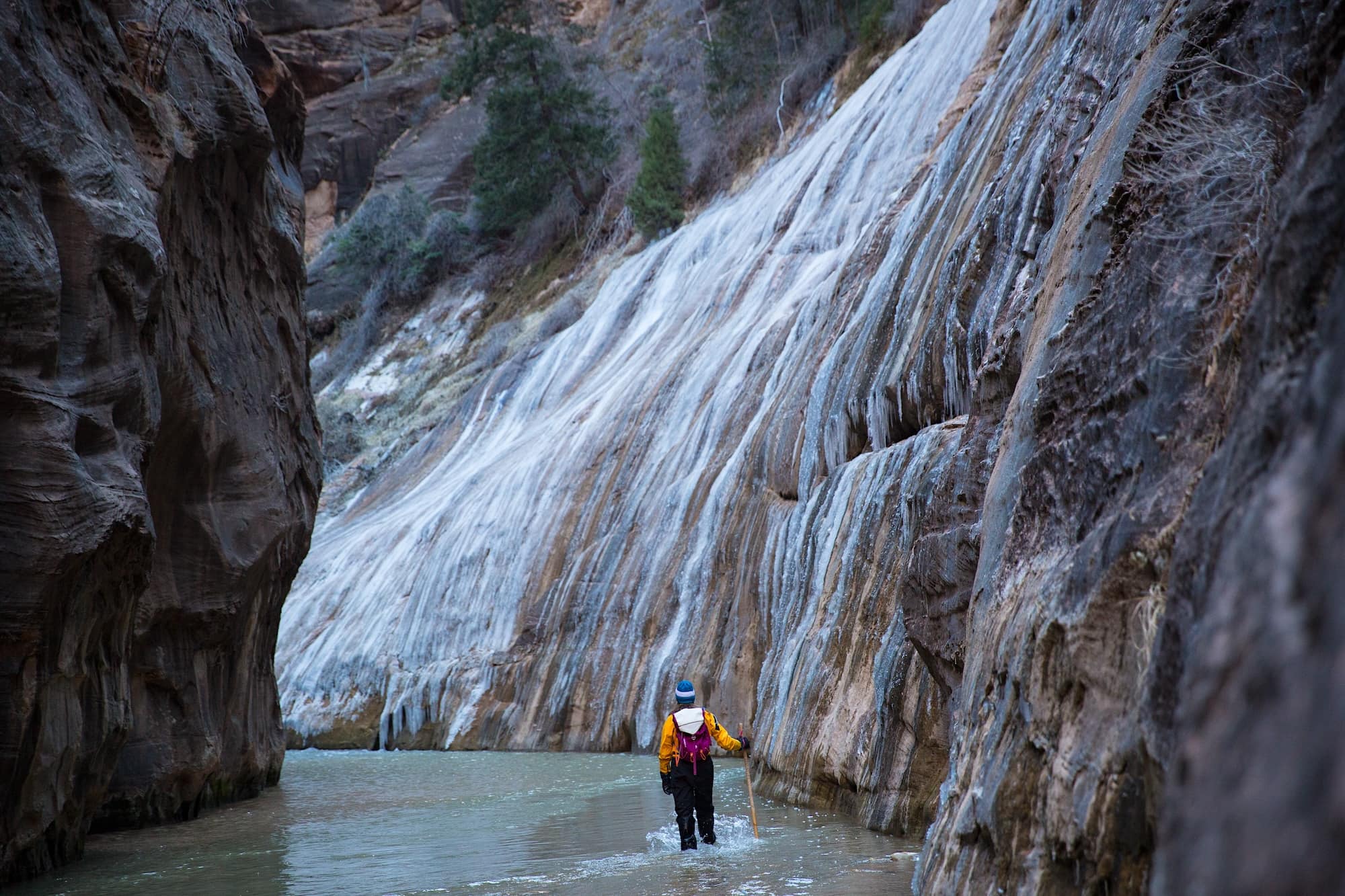
What to Pack
Planning appropriately and having the right gear, extra layers, and food/water is essential. Consider renting gear through one of the local outfitters if you don’t have the list of essentials below:
Hiking poles: A hiking pole is highly recommended to stabilize your footing. A sturdy stick will help you balance while crossing unstable rocks through the river’s current.
Neoprene booties: No matter your footwear, wear neoprene booties instead of socks with your hiking shoes or boots. Made of a wetsuit-like material, they will keep your feet warm even after being immersed in cold water for hours.
Clothing: What you wear will depend on the weather. Regardless, you should wear quick-drying clothing and pack additional warm layers. Hikers can wear shorts with layers to keep their core toasty on warmer days. On cooler days or with higher water levels, dry pants or bibs are recommended and can be rented at a gear shop in town. Dressing in layers is best, as the temperature can quickly change. Avoid cotton clothing, which will stay wet. If you’re hiking in the winter, you will want a full dry suit kit with thermal layers underneath.
Extra Layers: It’s much colder in The Narrows than in the rest of the park because you’re hiking in the shade through freezing water and often with a breeze. Bring extra layers, preferably in a dry bag, in case you get wet or cold, such as a beanie, gloves, a down jacket or insulating layer, a rain jacket, and rain pants.
Food & Water: As with any hike, pack plenty of food, water, and snacks for the journey. There are no facilities to refill.
First Aid Kit: Grab a simple kit with the necessities.
Keep An Eye on Safety
The main risks in the Narrows are tripping and falling, flash flooding, and hypothermia. Having the proper footwear, gear, and knowledge is essential.
Flash floods can occur even when they’re not expected. If precipitation is forecast, there is a chance of flash flooding. Thunderstorms usually build in the afternoon in the summer but can occur at any time. Know the signs to look for, including a buildup of clouds/sounds of thunder, changes in water clarity, floating debris, or a roar from the canyon. Always be conscious of your surroundings and the weather around you.
Find Your Next Adventure
Get epic travel ideas delivered to your inbox with Weekend Wanderer, our newsletter inspiring thousands of readers every week.
Seen in: Hikes, National Parks, Utah, Zion National Park






